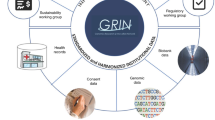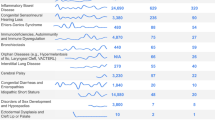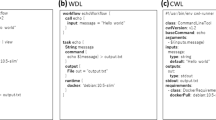Abstract
Large-scale collaborative research will be a hallmark of future psychiatric genetic research. Ideally, both academic and non-academic institutions should be able to participate in such collaborations to allow for the establishment of very large samples in a straightforward manner. Any such endeavor requires an easy-to-implement information technology (IT) framework. Here we present the requirements for a centralized framework and describe how they can be met through a modular IT toolbox.
This is a preview of subscription content, access via your institution
Access options
Subscribe to this journal
Receive 12 print issues and online access
$259.00 per year
only $21.58 per issue
Buy this article
- Purchase on Springer Link
- Instant access to full article PDF
Prices may be subject to local taxes which are calculated during checkout

Similar content being viewed by others
References
Schulze TG . Genetic research into bipolar disorder: the need for a research framework that integrates sophisticated molecular biology and clinically informed phenotype characterization. Psychiatr Clin North Am 2010; 33: 67–82.
Sullivan PF . The psychiatric GWAS consortium: big science comes to psychiatry. Neuron 2010; 68: 182–186.
Unutzer J, Choi Y, Cook IA, Oishi S . A web-based data management system to improve care for depression in a multicenter clinical trial. Psychiatr Serv 2002; 53: 671–678.
Heiman GA, King RA, Tischfield JA . New Jersey Center for Tourette Syndrome sharing repository: methods and sample description. BMC Med Genomics 2008; 1: 58.
Mailman MD, Feolo M, Jin Y, Kimura M, Tryka K, Bagoutdinov R et al. The NCBI dbGaP database of genotypes and phenotypes. Nat Genet 2007; 39: 1181–1186.
Lin Z, Owen AB, Altman RB . Genetics. Genomic research and human subject privacy. Science 2004; 305: 183.
Kahn SD . On the future of genomic data. Science 2011; 331: 728–729.
Warner V, Wickramaratne P, Weissman MM . The role of fear and anxiety in the familial risk for major depression: a three-generation study. Psychol Med 2008; 38: 1543–1556.
Weissman MM, Brown AS, Talati A . Translational epidemiology in psychiatry: linking population to clinical and basic sciences. Arch Gen Psychiatry 2011; 68: 600–608.
Almqvist C, Adami HO, Franks PW, Groop L, Ingelsson E, Kere J et al. LifeGene–a large prospective population-based study of global relevance. Eur J Epidemiol 2011; 26: 67–77.
Thorisson GA, Muilu J, Brookes AJ . Genotype-phenotype databases: challenges and solutions for the post-genomic era. Nat Rev Genet 2009; 10: 9–18.
Webb AJ, Thorisson GA, Brookes AJ . An informatics project and online ″Knowledge Centre″ supporting modern genotype-to-phenotype research. Hum Mutat 2011; 32: 543–550.
Zhang J, Haider S, Baran J, Cros A, Guberman JM, Hsu J et al. BioMart: a data federation framework for large collaborative projects. Database (Oxford) 2011; 2011: bar038.
Dangl A, Demiroglu SY, Gaedcke J, Helbing K, Jo P, Rakebrandt F et al. The IT-infrastructure of a biobank for an academic medical center. Stud Health Technol Inform 2010; 160 (Pt 2): 1334–1338.
Helbing K, Demiroglu SY, Rakebrandt F, Pommerening K, Rienhoff O, Sax U . A data protection scheme for medical research networks. Review after five years of operation. Methods Inf Med 2010; 49: 601–607.
Pommerening K, Sax U, Müller T, Speer R, Ganslandt T, Drepper J et al. Integrating eHealth and medical research: The TMF data protection scheme. In: Blobel B, Pharow P, Zvarova J, Lopez D (eds). eHealth: Combining Health Telematics, Telemedicine, Biomedical Engineering and Bioinformatics to the Edge. Akademische Verlagsgesellschaft Aka GmbH: Berlin, 2008, pp 5–10.
Faldum A, Pommerening K . An optimal code for patient identifiers. Comput Methods Programs Biomed 2005; 79: 81–88.
Terdiman J, Gul J . PS1-39: The Kaiser Permanente Northern California Oracle Research Database. Clin Med Res 2011; 9: 168–169.
Acknowledgements
This work is supported by the Deutsche Forschungsgemeinschaft through the Clinical Research Group 241 ‘Genotype-phenotype relationships and neurobiology of the longitudinal course of psychosis’ (http://www.kfo241.de; grant number SCHU 1603/5-1).
Author information
Authors and Affiliations
Corresponding authors
Ethics declarations
Competing interests
The authors declare no conflict of interest.
Additional information
Supplementary Information accompanies the paper on the Molecular Psychiatry website
Supplementary information
PowerPoint slides
Rights and permissions
About this article
Cite this article
Demiroglu, S., Skrowny, D., Quade, M. et al. Managing sensitive phenotypic data and biomaterial in large-scale collaborative psychiatric genetic research projects: practical considerations. Mol Psychiatry 17, 1180–1185 (2012). https://doi.org/10.1038/mp.2012.11
Received:
Revised:
Accepted:
Published:
Issue Date:
DOI: https://doi.org/10.1038/mp.2012.11
Keywords
This article is cited by
-
Pseudonymization for research data collection: is the juice worth the squeeze?
BMC Medical Informatics and Decision Making (2019)
-
Das deutsche Forschungsnetz zu psychischen Erkrankungen
Der Nervenarzt (2016)
-
A generic solution for web-based management of pseudonymized data
BMC Medical Informatics and Decision Making (2015)
-
Development of a bipolar disorder biobank: differential phenotyping for subsequent biomarker analyses
International Journal of Bipolar Disorders (2015)



